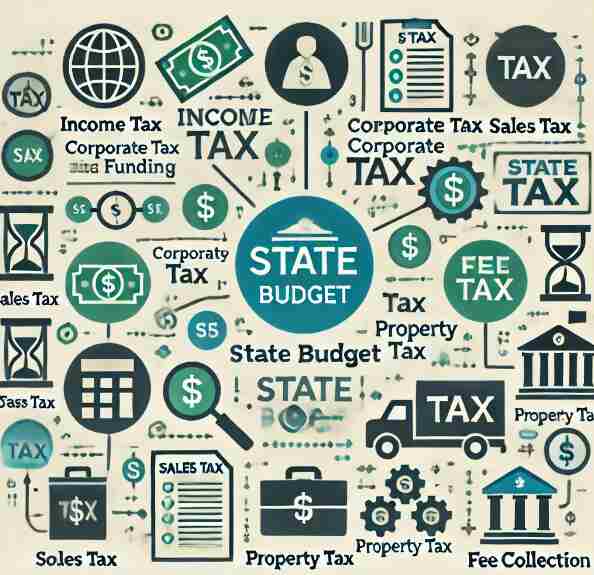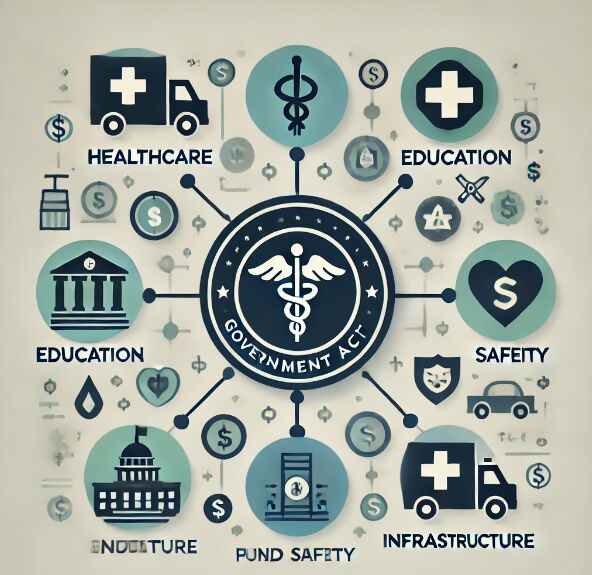With each budget cycle, there come questions, changes, and often a little uncertainty. The items at stake in any particular state budget are wide-ranging-from school funding to structures for healthcare improvements to infrastructure investments-the list is never-ending. But to make many of these priorities a reality, the government utilizes specific legislative tools. One key example of that is an Act Concerning Revenue Items to Implement The Governor’s Budget.
While this may sound like policy speak, it is a mechanism intended to work towards the state meeting its obligations and attaining its aims. The Act does attempt to balance funding for programs deemed indispensable with judiciously picked revenue sources. This article will explain what the above-mentioned legislation is all about, break down how it creates revenue, and surmise its possible impact on the state, the local economy, and, ultimately, people just like you.
Table of Contents
ToggleWhat is an Act Concerning Revenue Items to Implement The Governor’s Budget?
In essence, an Act Concerning Revenue Items to Implement The Governor’s Budget pertains to a measure that can facilitate money and revenue towards the realization of the budgetary allocation as proposed by the governor himself. When a governor proposes a budget, there are priorities and objectives for the coming fiscal year. In most instances, such goals entail raising or reallocating funds through taxes, fees, or some other form of revenue mechanism.
Concretely, this would be the Act that identifies the sources of revenues, changes in the current tax rate or structure, and financial policies that will strike a balance in the state budgets. Changes can involve income taxes, corporate taxes, property taxes, or special fees on certain services or industries.
This Act is important for residents as it displays how varied the funding of programs by the state is in daily life money funding K-12 schools to public health services and fixes to roads. Revenue decisions within this Act have real-world consequences for communities.
Revenue Sources at Which the Act is Aimed
An Act Concerning Revenue Items to Implement The Governor’s Budget, therefore, primarily aims at the identification and outline of the major revenue sources that shall form the basis for the state’s budgetary goals. These usually encompass a varied scope of changes in taxation, including:

- Income Taxes: Changes in income taxes are one of the most popular ways states make up revenues. It may include minor amendments to this Act that may alter either the income tax rates, credits, or deductions. Since changes affect both individuals and businesses, residents, depending on the income bracket or exemption, may experience minor increases or decreases in the amount of taxes owed.
- Corporate Taxes: Businesses also help states generate revenue. The Act may recommend reviewing the structure of corporate taxation, the tax rates or even taxes leveled against specific industries. One would balance this tightrope of corporate taxes: large revenue streams come hand-in-hand with increased corporate taxes, but if too high, corporate taxes may discourage businesses from investing in the state.
- Sales Taxes: Sales tax is a big source of collection for all states. The Act may grant a percent reduction or may bring about changes in the exemption within the tax rates, new category, or transition scope coming within the ambit of taxable or exempted goods and services. This can be directly reflected in consumer spending and, therefore, impact local businesses. For instance, reduced sales tax on items of necessity shall ease financial burdens among residents, while expansion of the sales tax base to more goods or services would increase overall revenue.
- Property Taxes: Property taxes generally finance local services and are normally administered at the level of local government. However, they may be influenced by state budgetary decisions where certain adjustments or caps might be enacted on the property tax rates where funding gaps need to be bridged.
- Special Fees and Excise Taxes: Other revenue can be supplied through excise taxes on certain goods-tobacco, alcohol, or even digital services. Special fees may also be applied to certain services provided by or licensed through the state. These fees can vary greatly but represent a growing part of state revenue plans as governments look to diversify their funding base without greatly affecting income or property taxes.
These revenue sources are selected with a purpose: to provide the needed funds while not overburdening the taxpayer. This is a delicate balance that must be struck so the state can finance its projects without striking a serious blow to either its citizens or businesses.
Understanding the Governor’s Budget and Its Goals
Each of those governors has his special view on what the future of that state should be like, and in this respect, the budget reflects his priorities. Generally speaking, a governor’s budget outlines comprehensive goals that seek to enhance the general well-being of the state. Examples of such goals include educational reforms, expansion of healthcare, improvement of infrastructure, and social services.
For example, if the governor has emphasized that public health is the top priority, then the budget will include spending a little bit more on health programs, mental health programs, or improving public hospitals. For example, if it had been education at the top of their list of priorities, most of the funding would go to school districts, colleges, and vocational training. An Act Concerning Revenue Items to Implement The Governor’s Budget directly supports priorities such as these by making sure that the state has sufficient funds to meet the goals stated.
The most urgent needs of a state, such as decaying infrastructure or an increased availability and affordability of housing, drive the governor’s budget goals. Knowing these helps place into context how this Act serves as the financial roadmap to fund these efforts. The revenue gained from this Act allows the state to move forward with these kinds of initiatives and hopefully help increase the quality of life for all those in its borders.
Changes to Taxation that the Act Proposed
The most talked-about issue of An Act Concerning Revenue Items to Implement The Governor’s Budget has to do with the changes to taxation. Everything from income tax to corporate tax to sales tax-if it is changed, either slightly or by a landslide, will affect residents and businesspeople alike. Let’s take a closer look at some typical taxation changes that may be seen with this type of Act:
- Income Tax Adjustments: These may involve differentiation with regard to income brackets. For instance, relief can be given to low-income earning households or a slight increase for higher earners. These changes are normally done as balancing acts between revenue generation and equity in taxation.
- Corporate Tax Policies: At times, the Act may give small businesses opportunities and tax breaks in certain industries that need stimulation. By dozing off corporate taxation rates or deductions, the state balances economic growth with revenue objectives.
- Sales Tax Expansion or Reduction: Sales tax changes tend to be far-reaching in application due to the everyday nature of purchases. For example, the Act may lower the sales tax on commodities like groceries or medications to help low-income citizens, or it may extend the sales tax to other services as a revenue growth method.
- Property Tax Revisions: In terms of property taxes, this is almost universally referred to by local governments to set rates. Of course, state decisions might influence property taxes. The Act may include property tax caps or revising in the case of some funding shortfalls or any specific funding requirements.
- Excise Taxes on Certain Commodities: Most excise usually falls on commodities, like alcohol, tobacco, or fuel. These are sometimes manipulated in order to increase revenue, especially when the state has particular priorities in either health or environmental programs.
These are usually discussed in the larger context of budget hearings and further refined to ensure that the final version of the Act meets the governor’s priorities.
Using the Act to Finance Public Services
Perhaps the most important intention of An Act Concerning Revenue Items to Implement The Governor’s Budget is to ensure that certain aspects of public service get decent funding. Certain priorities where revenue appropriations by the Act make a difference are:

- Education: The funding in any particular state budget for K-12 schools, public universities, and vocational programs are major line items. This Act helps them secure funds to attain teacher salaries, school facilities, technology upgrades, and student aid programs.
- Healthcare Services: Other examples include public health clinics and mental health resources. The Act provides necessary funds so that residents can have access to medical services. During states of emergency, such as when there is a public health crisis, these funds become more needed.
- Infrastructure: Roads, bridges, and public conveyance form part of the very basics of daily life and economic development. Revenue generated through the provisions of this Act enables renovation, and expansion projects, and sustains the state’s infrastructure besides ensuring increased safety and access to modes of transportation for its citizens.
- Public Safety: The police, fire departments, and other rescue services operate based on state funding. The act makes sure that adequate funding is available to ensure such services work efficiently and, therefore, ensure safety in the environment for one and all.
- Social Services: Services that meet the needs of families, the elderly, and the poor rely on the revenue brought in by the state. The Act gives financial assistance to programs that provide subsidized housing, supplemental nutrition, and employment preparation.
Balancing Revenue with Economic Growth
This challenge continues to be fundamental to state budgeting, the need to balance revenue needs with the competing goal of fostering economic growth. An Act Concerning Revenue Items to Implement The Governor’s Budget strikes such a balance in selecting a revenue source or sources carefully to minimize potential negative impacts on businesses and individual taxpayers. This could also involve the imposition of certain supportive measures for local businesses, providing tax credits or grants.
In this way, such provisions are supposed to neutralize the burden of new or more intensified taxes, enabling businesses to continue their activities while at the same time taking part in state revenue. It is theoretically supposed to be a win-win situation wherein the state addresses its budgetary requirements without having to strangle economic growth.
Because of this, sustainable revenue sources are particularly valuable insofar as they create a financial base that the state can realistically use to make some sort of long-term planning, as opposed to constant reassessment of taxes and/or fees to make up for budget deficiencies. It can include anything from encouraging industries that would provide a continuing source of revenue, investment in initiatives that would spur local economies, or even devising incentives for businesses that would bring long-term economic benefits to a state.
Addressing Public Concerns and Questions
While An Act Concerning Revenue Items to Implement The Governor’s Budget is made to help the state as a whole entity, it is pretty natural for residents to have questions about how those revenue changes will matter to every one of them. In this section, we’ll answer a few common questions:

Will my taxes go up?
The changes this Act will bring to individual taxes depend on what is contained therein. It could be that, with adjustments in income tax, some of the income brackets may go up, especially for those who earn much. On the other hand, the Act may include in its provisions some tax credits and exemptions for lower-income households that would somewhat nullify the additional impact.
How does this play out for local businesses?
Corporate tax-rate changes or changes in the expanded sales taxes would lower consumer spending. Typically, there has been a balance sought by providing numerous facilities or reliefs to small business earners under the Act to enable the economy to be developed. It may include tax credits, grants, or programs of assistance to businesses to expand and at the same time contribute to state revenue.
What benefits will we get from this Act?
Revenue generated from the action of this Act is translated into key services that at times have immediate and long-term positive impacts. For instance, some of the visible changes in local infrastructure, increased educational resources, and availability of health care can be accrued to more funding. Programs for public safety, housing, and job training round out this approach to building a more robust and resilient community.
Could this Act affect property taxes?
While the taxation of property generally is a matter of local concern and control, revenue policies of the state may have indirect effects: for example, to the extent the Act finances local schools or other infrastructure, the burden on local governments to increase property taxes may be reduced. Conversely, when state revenues are inadequate, local jurisdictions may be inclined to increase property taxes to fund essential services.
Does it protect vulnerable populations?
Yes, the Act has taken many measures under this law to treat the vulnerable populations of seniors, low-income families, and people with disabilities more protectively. For example, the Act generally provides dedicated funding for social services and public health programs for these types of priority populations. In instances, tax credits may also be utilized with exemptions and other relief measures in place to protect these individuals from bearing a disproportionate share of any revenue increases.
Learning from Other States and Past Budgets
The different revenue strategies in An Act Concerning Revenue Items to Implement The Governor’s Budget are by no means devised in a vacuum. Often, they are modeled after particularly effective approaches in other states or lessons learned from past budgets. Other states that have somewhat similar economic profiles may have useful experiences to share regarding what works and what doesn’t in generating revenue.
For example, many states have been able to diversify their sales tax base to include services sound way of securing constant revenue without causing harm to a specific industry. Others have imposed “sin taxes” on products such as tobacco or sugary beverages, which raise funds and also help improve public health. All these examples are studied in detail by policymakers to make informed decisions that support budgetary needs and mitigate unintended consequences.
Similarly, being able to study the outcome of past budgets will allow for verification of where revenues could have been more suitably adjusted or where budget allocations may have fitted better. This will grant the policymakers the privilege of adjusting their strategies and coming up with something that will be more functional and sensitive in nature.
Public Contributions to the Budgeting Process
Public participation is one of the most important ingredients in any budgetary legislation. A revenue item act to implement the Governor’s Budget is informed not only by economic considerations but importantly by the concerns and feedback of residents about priorities. Town halls, public hearings, and community forums are opportunities for citizens to express opinions, make inquiries, and hold policy thinkers accountable.
By participating in the budget process, residents can play a part in shaping the course of revenue policies. Whether it be a call for lower taxes, more money for schools, or increased investments in healthcare, input from the public plays a consistent role in the legislative process. Transparency and accessibility have become increasingly important topics to state governments, and several provide online resources, detailed budget summaries, and updates regarding proposed legislation.
Why Understanding Budget Legislation is Important
While information about budget legislation may get overly technical, understanding An Act Concerning Revenue Items to Implement The Governor’s Budget helps residents make decisions regarding their communities and futures. It allows laymen to understand the generation and disbursement of revenues, thus truly appreciating the role they can play in shaping state priorities through advocacy, voting, and involvement in the community.
The Act reminds us that budgets are not about numbers; instead, they are about the values, needs, and aspirations of citizens. Every revenue line item in the Income-tax adjustment, new fee, or expanded sales tax is part of a greater plan for a successful state with available public services, solid infrastructure, and economic opportunities.
Conclusion Thoughts: Responsibility of Everyone
Ultimately, An Act Concerning Revenue Items to Implement The Governor’s Budget is more than balancing the books; it is building a sustainable and prosperous future for all. Every dollar raised, and every tax policy adjusted was to build a community where people feel safe and supported, a place to prosper. Of course, this can only be possible if this Act for that matter, any other budget-is managed collaboratively.
That means policymakers, residents, and businesses all do their part in making the state’s economic policies reflect a commonly shared vision. It is the right and responsibility of each resident to be informed, join the public debate, and demand change when necessary to make the budget work for all.
So, considering the mentioned impacts of the legislation, let’s remember that budgeting is a shared responsibility. It’s with initiatives like An Act Concerning Revenue Items to Implement The Governor’s Budget that we can move forward into a future in which the state’s resources would be put to their prudent use, effective use, and to the service of every member within the community.
Get expert tips and financial guidance at LookMyFinance.com






